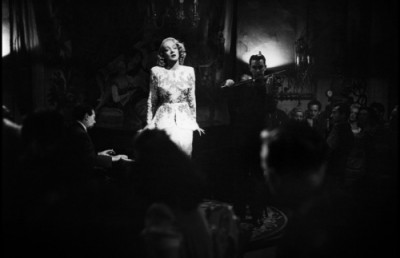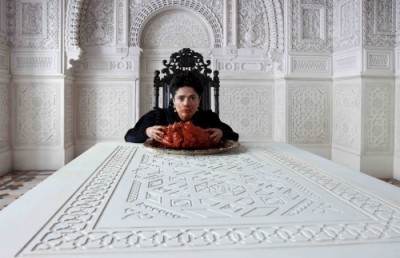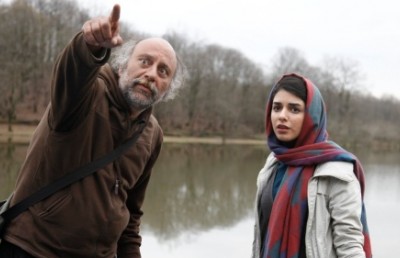‘Diving’ Into Le Scaphandrier (2015, Alain Vezina)
or, How to Make an Old fashioned Slasher film in Quebec
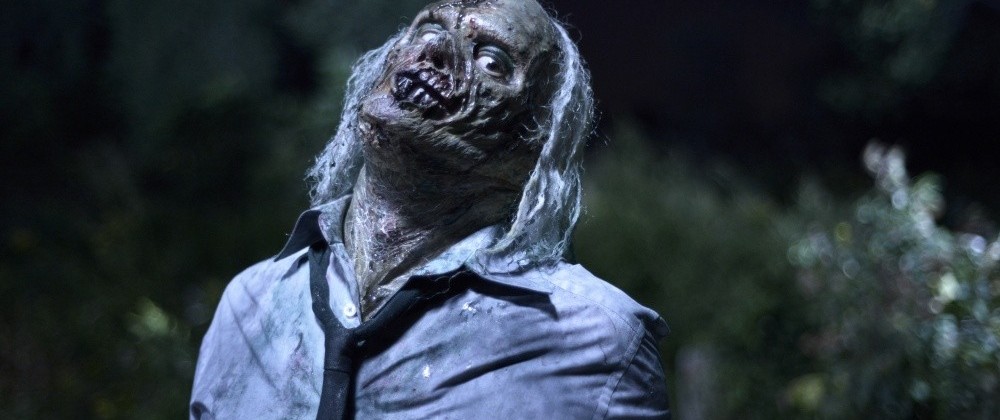
Warning: This review contains spoilers…lots of them
In an age of smug, self-conscious horror films, director-writer Alain Vezina’s low budget retro slasher Le Scaphandrier (2015) (English title Death Diver) plays the genre elements straight and by the number, decidedly not re-inventing the wheel, but revisiting it. Historically, the capital cost allowance period (1974-1988) was the moment of the bona fide Canadian, old fashion slasher film. The peak period of the CCA saw the release of such seminal slasher/stalker films as Prom Night (Paul Lynch, 1980), My Bloody Valentine (George Mihalka, 1982), Humongous (Paul Lynch, 1981), Happy Birthday to Me (J. Lee Thompson, 1980), Terror Train (Roger Spottiswoode, 1980), and Visiting Hours (Jean-Claude Lord, 1981). Although several of the above were filmed in Quebec (Happy Birthday to Me, Visiting Hours and Terror Train ), they were shot in English. Alain Vezina’s low budget retro slasher Le Scaphandrier is (I believe) the first Quebec made slasher film in the classic mode to be shot entirely in French. Several other recent films have attempted to rekindle the old Canadian-Quebec slasher film tradition, in completely different ways. Writer-director Renaud Gauthier’s 2013 Discopathe was an attempt to replicate the mood, setting and ambiance of the 1970s, a la Tarantino/Rodriguez. The film opens in New York circa 1976 and then flashes ahead to Montreal 1980, and includes dialogue in both English and French. Contrarily, the micro budget Gore, Quebec (2014, Jean Benoit Lauzon), shot in English, and Le Scaphandrier, do not hide their contemporary setting, but, to varying degree, follow the generic pattern of the slasher film. 1
In Le Scaphandrier a present day sleepy Quebec rural community is haunted by its maritime past, in the form of ghastly ghouls (which I prefer to zombie) from a 1935 shipwrecked ocean liner named “The Princess of the North”, who return to reclaim what is rightfully theirs: objects looted by a schooner magnate named Mr. Sauvageau. On paper the plot reads like a classic morality yarn from a 1950s EC comic book. And it plays that way too, even with some of the streak of dark humor found in many EC Comic stories.
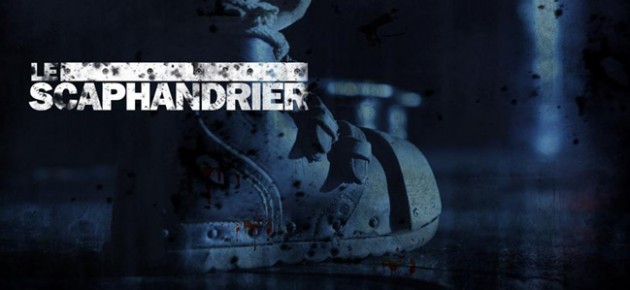
As the film picks up Mr. Sauvageau’s son Armand (played by veteran Quebec actor Raymond Bouchard) is continuing his family’s suspect collection of precious shipwreck objects with his ship The Deep Salvage, which is spotted by the coast guards adrift at sea in the film’s opening scene. A nice credit scene follows, designed in sepia toned comic book animation (homage to EC Comics?) that depicts underwater adventures that foreshadow the plot. The two police officers board the abandoned ship. A brief insert shot of a newspaper byline plants plot information on Armand Sauvageau, “explorer of the wreck of the Princess of the North”. The insert turns into a subjective shot of a heavily breathing off-screen presence, glimpsed (symbolically) in a threatening shadow cast over the newspaper image of Sauvageau. The two officers come across the mutilated remains of the crew, causing them both to vomit —not something you’ll normally see in a slasher film.
An ambitious and bored young journalist for the local newspaper de l’Écho du Fleuve, Julie Belley (Édith Côte-Demers), new to the community, is urged by her newspaper boss Félix Lamontagne (Jean-Guy Bouchard) to investigate the mysterious deaths connected with Deep Salvage. Julie enlists the help of the town’s timid museum archivist Alexandre (Alexandre Landry), who has knowledge of the precious objects looted from the Princess of the North, including a gem encrusted 12th century book, The Rubaiyat, which is in the possession of Mr. Sauvageau. Alexandre gives her a lead for an interview with the daughter of diver Joseph Bilodeau, the man who Sauvageau hired in 1935 to find The Rubaiyat. Julie goes to interview the daughter, Marielle (Béatrice Picard), and learns that she holds a grudge against Armand Sauvegeau, for the senior Sauvageau’s implication in the death of her father. As she explains it, Mr. Sauvageau senior hired Bilodeau to search the Princess wreck for The Rubaiyat, but when he died during the hunt Mr. Sauvageau made little effort to look for her father’s body, fixating instead on finding the Rubaiyat. Mr Sauvageau was also mysteriously lost at sea, an act of justice for his sins, claims the bitter Marielle.
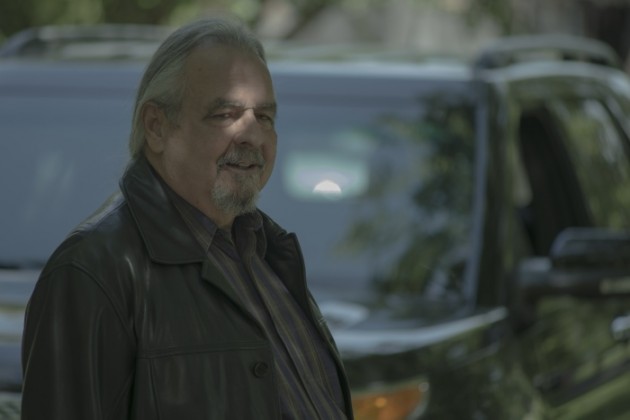
Town baddie Armand Sauvageau
As Julie and Alexandre slowly piece together their clues, the body count rises around them, first the crew of The Deep Salvage, then Julie’s boss and his secretary Johanne (Pascale Létourneau), a submarine crew, in homage to classic slasher sexual morality, a teenage couple petting heavily in a light house, and the local bar owner, Raymond Vallée (Benoît Rousseau), one of Sauvageau’s divers. In each case the victim has a connection to the Deep Salvage, or possesses an object stolen from the Princess of the North, giving the murders an EC styled poetic justice. Vezina adds some clever visual irony, as in the scene where the ghost diver attacks the crew of a submarine in search of stolen artifacts. The scene’s final shot is a tight close-up of a pocket watch on a table, with a stack of $20 bills next to the watch. The killer’s bloodied glove hand grabs the watch and drags it across the table, leaving a streak of blood forming a perpendicular line opposite the stack of bills. Vezina lets the symbolic meaning of this juxtaposition linger for several seconds before fading to black.
Following another slasher film protocol, the murders are committed with decidedly non-technological weapons, a knife, a harpoon, an axe and a steel chain count among some of the weapons. The murrders are also graphic, with separated limbs, eye gouges, a harpoon through a mouth, a maggot infested head, a gaping chest exposing a pumping heart and spilled intestines.
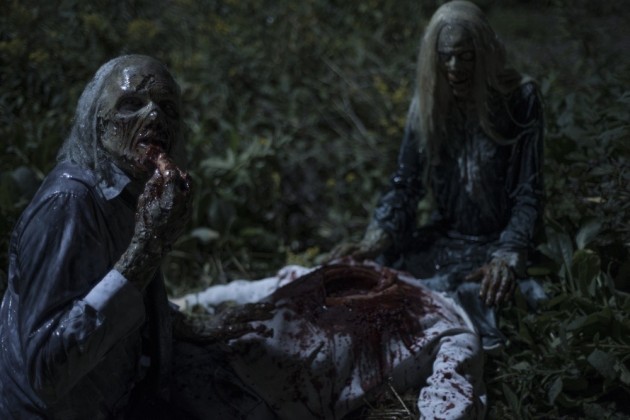
In the film’s gory climax, Sauvageau and his gun toting lackeys have a stand-off with the mute killer in the diving suit,and his band of ghoul passengers. The singular figure of the diver is as driven to recuperate The Rubaiyat as Armand is to keep it. Sauvageau’s men appear overly confident with their rifles, before they realize what they are up against. The ghouls overwhelm the men and, in a colorized version of Night of the Living Dead, have a cannibal feast, ripping and gnarling flesh off limbs and other assorted human body parts (at this point you would be excused for thinking these ghouls are zombies!). A horde of ghouls swoop in on Julie and Alexandre in their car, but they are saved by the sound of the ship’s foghorn, which acts as the Pied Piper’s flute leading the rats out of Hamelin. The ghouls turn to join their ‘leader’, the mute ghost diver, as he confronts Sauvageau, who wisely hands over the precious book to its rightful owner. As the diver walks away the ghouls, which include children, attack Armand and devour him like a pack of rats. While the ghouls munch away at Armand in the background, the diver empties out a burlap bag of reclaimed looted objects, and drops them into a heap on the ground. The sound of the clanging objects freezes the ghouls, who stop their feast and turn toward the pile of objects. The ominous music gives way to gentle strings, changing the tone from horror to nostalgia, as the ghouls, one by one, collect their personal object (the captain picks up a binocular, a child picks up a doll, a woman her wedding ring, another a comb, etc.). An impressively lit final image of the ‘monsters’ frames the diver in silhouette against the fog filled night leading them back in the direction of the off-screen foghorn. This penultimate scene of the film is a simple execution of light, shadow and color, maybe even lifted from Lamberto Bava’s 1980s Demons, but unique and effective nonetheless; perhaps even elegiac.
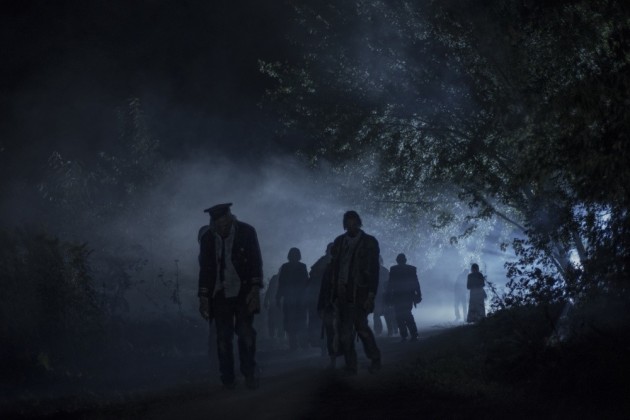
Le Scaphandrier has an intentionally retro feel, not in the inclusive sense of Discopathe, but in its dialogue and characterizations, which may inadvertently turn some viewers against the film. The one element which does detract from its retro feel are the weak digital effects, used mostly to visualize the external shots of the ocean liner ship and submarine, which were, I imagine, beyond the film’s budget and production means. In terms of the acting, while most of the major roles are believable, some of the secondary roles feeling stilted, and there is an odd queasiness in terms of the sexual politics in the lascivious behavior of ALL the middle age men in the film toward the attractive young journalist Julie, as if a young woman has not set foot in the community in decades. And contrarily, the single male of her age, museum archivist Alexandre, is too timid to make any sexual advances. While this sexist behavior may have passed in the 1970s or 1980s, it feels awkward in 2015. Though Julie is not a classic Final Girl, she doesn’t seem to have any real sexual options in the town –maybe that explains why she routinely engages in talk with the community priest, L’Abbé François St-Juste (Widemir Normil), whose Haitian background seems to provide him with the necessary belief in the supernatural.
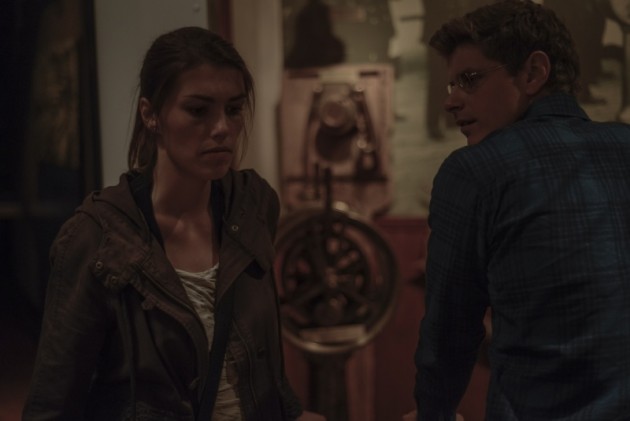
Julie and Alexandre
And yet while not re-inventing the slasher or stalker film, Vezina does add a few new wrinkles to the mix, such as the killer’s diving suit costume, the fact that the killer remains unidentified, and the way the ghouls are ‘humanized’ at the end. With the figure of the stoic diver in full costume Vezina has added a neat addition to the roll call of slasher figures that include Leatherface, Michael Myers, Jason, Freddie, Jacob Goodnight, and a host of others. The suit not only hides the identity of the killer but provides a compelling image of an expressionless killer. 2 And Vezina resists the temptation of over using his prop by giving us only one classical subjective point of view shot through the diver’s grated helmet, a neat visual trick which reflects the film’s ability to be both retro and fresh. In a gesture that is pretty unique to the slasher film, the identity of the killer diver is not revealed, right up until the end credits, where he is simply named ‘Le Scaphandrier’ (the diver), played by actor Éric Gagne. Therefore the script leaves the identity of the diver up to the viewer to decide. Perhaps he is Joseph Bilodeau, the diver hired by Armand’s father to lead the original search expedition of 1935? Or maybe he is the original patriarch Mr. Sauvageau, returning to enact the ultimate sacrifice for the sins of his past, the murder of his son? Or maybe he is simply the unidentified captain of the Princess of the North? The motive for the return of the dead crew of the 1935 ocean liner —to retrieve their personal items stolen from them by greedy humans— makes them more sympathetic than the usual slasher movie antagonist. In fact, the more we see of the ghoulish ghosts, the more sympathetic they become, so that by their final scene, where each ghoul is personalized by a memento before returning to their watery grave, they have become tragic victims rather than vengeful killers —though they are that too.
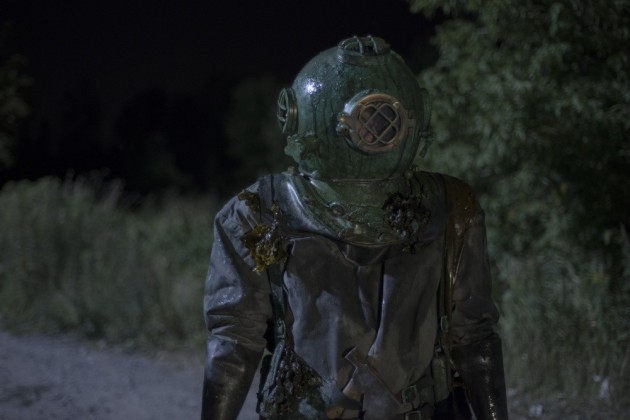
Although most reviews mark this as Alain Vezina’s debut feature, it is in fact his second fiction feature, having directed an adaptation of an 1836 short story by Theophile Gautier, La Morte Amoureuse, in 1994. In between these two fiction features Vezina became a specialist of maritime disasters, with four feature documentaries on the subject: Sombré dans l’oubli : l’histoire de l’Empress of Ireland, 1998 (The Empress of Ireland: The Forgotten Wreck), Le naufrage du Princess Sophia, 2004 (The Sinking of the Princess Sophia), La dernière mission : l’histoire du U-190, 2007 (The Last Mission: The History of the U-190), and Dans le sillage du Titanic : l’histoire du CGS Montmagny, 2011 (In the Wake of the Titanic: The Story of the CGS Montmagny). This documentary experience lends Le Scaphandrier a realism in its attention to maritime detail, most seen in the inside of Armand’s trophy house and the interiors of the museum, ships and submarine.
Writer-Director Vezina pays homage to at least a half dozen horror films, largely from the 1980s, but minus the postmodern winks. The film tries and largely succeeds in operating on two levels: as a straight forward EC Comics styled morality tale, and as an homage to a slew of mainly 1980s films, attempting to moderate contemporary gore with 1980s atmospherics. The opening on the Deep Salvage ship echoes Lucio Fulci’s Zombie, where two officer investigate an abandoned yacht docked outside New York city, and are attacked by the sole survivor, a lumbering zombie. The use of a small community recalls the mining town locale of My Bloody Valentine, as it does a closer to home film, Phil Spurrell’s The Descendant (2007, Canada), which deals with a small Quebec community harboring a dark secret from its past, and slave ghosts that return as a reflection of the community’s collective guilt over past sins. The film that seems most influential on Le Scaphandrier is Carpenter’s 1980 The Fog, with its coastal setting, atmospheric use of fog, and returning vengeful, murderous sailor ghosts.
Vezina takes his cue from master classicist Carpenter, by providing the film with a satisfying resolution rather than a modern or postmodern ending that leaves open the door for a return of the threat, and the inevitable sequel. The priest, François St-Juste, gets the final scene of the film, as he stands by the shoreline the morning after the final settling of scores, looking outward, Rosary in hand, he blesses the sea. He then turns to leave but something catches his eye below. He looks down and spots one of the looted objects, a bracelet, submerged under the crystal clear water, suggesting the spot is where the ghouls passed in returning to the ship only a few hours earlier. Father St-Juste bends to pick up the bracelet, offers a look of recognition, and then looks out to sea. Vezina gives the last say to nature, as the camera dollies forward past the priest to his point of view of the St-Lawrence River, 3 letting the shot linger on this empty frame of the rolling waves for several seconds before fading to black, resisting the (postmodern) temptation to re-introduce the threat….the sudden shock ‘twist’ ending of a ghostly hand thrusting up from the water, echoing a host of past films, from Deliverance, to Carrie, to Friday the 13th, to Haute tension, must have been very_ tempting for Alain Vezina.
+Photos used were graciously provided by Alain Vezina
Official website, includes trailer:
Notes
- Although the title of Maurice Deveraux’s Slasher (2001) would suggest slasher film lineage, this clever pseudo one-take game show horror film is not a brethren of the classic slasher film. ↩
- Although to be honest, an image that kept coming into my mind whenever the diving suit killer was on screen was Buster Keaton in an identical diving suit from The Navigator, not exactly a frightening proposition! ↩
- Oddly enough, Vezina’s first feature La Morte Amoureuse, made some twenty years before Le Scaphandrier, also ends on the shores of the St. Lawrence River. ↩



